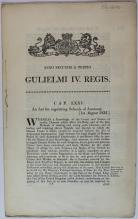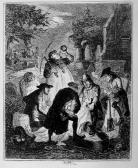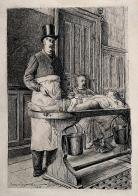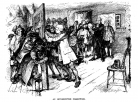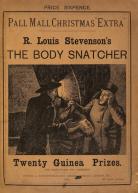Sydni Fuqua's Timeline: The Body-Snatcher
Created by Sydni Fuqua on Mon, 11/15/2021 - 15:01
Part of Group:
This timeline will follow events from the 18th century leading up to the publication of Robert Louis Stevenson's "The Body-Snatcher" in 1884. The timeline's focus is the birth and downfall of the resurrectionist profession and the unfortunate crimes that inspired Stevenson's short story.
Timeline
Chronological table
| Date | Event | Created by | Associated Places | |
|---|---|---|---|---|
| 1829 |
The Burke and Hare MurdersThe 1828 murders by William Burke and William Hare, hired by Dr. Robert Knox, served as the inspiration for Robert Louis Stevenson's "The Body-Snatcher." The two lodging house owners committed a series of sixteen murders that supplied Dr. Knox with the cadavers necessary for his anatomy lectures. These murders shook the country of Scotland and forced Parliament's hand to create the act that would put an end to the resurrectionist profession for good. This sketch by Robert Seymore appeared in the 1829 edition of The Murders of the Close, a novel published in London depicting the details of the horrific crimes that spanned a ten-month period. |
Sydni Fuqua | ||
| 1832 |
The Anatomy Act of 1832After centuries of families suffering from the horrific actions of resurrectionists, the government finally passes The Anatomy Act in 1832. This would end the profession of resurrectionists by allowing anatomists to use donated bodies for their personal studies and lectures. While legally the problem seemed to be solved, the public was still shaken and anxieties surrounding the criminal practice were still prevalent. Stevenson exposes the anxieties surrounding the continuation of the practice despite the legal repercussions in "The Body Snatcher." |
Sydni Fuqua | ||
| 1847 |
ResurrectionistsThis illustration by Hablot Knight Browne depicts the act of exhumation and the callous nature the men committing the crimes possessed. This specific depiction is of John Holmes and Peter Williams who were punished for their participation in the theft of twenty bodies with the intention to sell in 1777 (The Newgate Calander). This predecessor to the crimes that inspired Stevenson's "The Body-Snatcher" is an example of how the court system and the public despised resurrectionists from the very beginning. |
Sydni Fuqua | ||
| 1869 |
The AnatomistThis image by Jean-Jacques Rousseau depicts an anatomist dissecting a cadaver. While this etching was made in 1869 and published in 1889, it captures the cold environment of the dissecting room. The anatomists were the "employers" of the resurrectionists. The lack of available cadavers for educational purposes begins to dwindle from 1506 to 1752. As the demand for bodies increases, doctors begin hiring men to go out and rob graves of their tenants to be taken back to the lab and studied. This is the sort of classroom environment that Dr.K-- in "The Body Snatcher" would have taught Mr. Fetes in. |
Sydni Fuqua | ||
| 1882 |
Anatomy RiotsA series of riots in Europe and America blew up in 1788. Families were tired of the graves of their loved ones being desecrated by greedy doctors in the name of science. Unfortunately, their efforts would not incite any governmental interference until the 19th century. This is a sketch of a mob bursting in on an active dissection in an act of protest. The artist is unknown but the image was published in the magazine Harper's Weekly in 1882. |
Sydni Fuqua | ||
| 1884 |
The Body-SnatcherRobert Louis Stevenson's short story "The Body-Snatcher" was published in the newspaper The Pall Mall Gazette in 1884. Stevenson tells the story of a young medical student turned resurrectionist and his spiral into depression as the realization of his actions consumes his mind. |
Sydni Fuqua |


